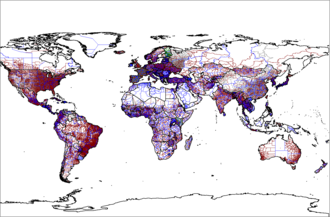Administrative unit
Areas resulting from the division of a national territory into areas of responsibility are defined as administrative units . Each area for which responsibilities have been defined within the public administration can be seen as a separate administrative unit.
Structure and names
The units of the regional structure are the superordinate and subordinate administrative levels . In many countries there are four to six such levels, which primarily include:
- Region , province (formerly also Gau ), governorate , etc. ( NUTS 1, NUTS 2 )
- Administrative district (in four German countries), in the Czech Republic and Slovakia regional association ( Kraj ), in England county , in Russia area ( oblast ), in France, Greece and Japan prefecture etc. ( NUTS 2, NUTS 3 )
- District , urban district or statutory city , administrative or political district ( NUTS 3 )
- District as partially joint administration of independent communities in the same district; Named very differently in the German federal states: z. B. in Bavaria administrative community , in Lower Saxony joint municipality or in Rhineland-Palatinate Verbandsgemeinde ; elsewhere also judicial district and other ( LAU 1 )
- Political municipality as the lowest administrative unit ( LAU 2 )
for different purposes it can be divided into:
Many municipalities are further subdivided for holding political elections ; the electoral districts usually have a population of a few hundred (see also election commission ).
In federal states, administrative units can exist at both the state and federal level. The latter can, but do not have to, orientate themselves on the borders of the sub-states. Sub-states are referred to as provinces in Canada , Argentina , South Africa, and Pakistan .
The municipalities as the lowest administrative unit
In the states of continental Europe, the “municipalities” (see municipality ) have their own legal personality. Like the state itself, they are understood as “ regional authorities ”, which have sovereign rights in specific areas of competence in a delimited territory. Parliaments and local councils are legally “ organs ” of this body. The concept of administrative units with their own legal personality is unknown to the states of common law : districts or counties do not exist in the legal sense. The traditional conception of the English law of the identity of state and crown corresponds to the fact that rights and obligations are assigned only to certain institutions, in the case of local government, the local authorities or local councils.
See also
- List of sub-state administrative units by population
- List of sub-state administrative units by area
- Subnational administrative units , list of national administrative divisions by state
Individual evidence
- ^ Hellmut Wollmann : Reforms in local politics and administration . VS Verlag, 2008, ISBN 978-3-531-15748-1 , pp. 24 .

